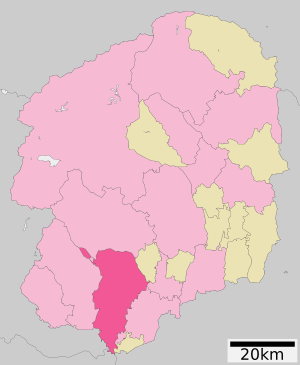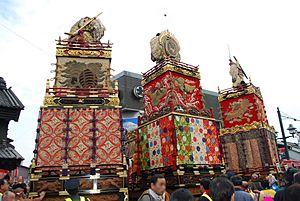Tochigi (city) facts for kids
Quick facts for kids
Tochigi
栃木市
|
|||
|---|---|---|---|
 |
|||
|
|||

Location of Tochigi in Tochigi Prefecture
|
|||
| Country | Japan | ||
| Region | Kantō | ||
| Prefecture | Tochigi | ||
| First official recorded | 40 BC | ||
| City Settled | April 1, 1937 | ||
| Area | |||
| • Total | 331.50 km2 (127.99 sq mi) | ||
| Population
(June 1, 2023)
|
|||
| • Total | 151,842 | ||
| • Density | 458.045/km2 (1,186.332/sq mi) | ||
| Time zone | UTC+9 (Japan Standard Time) | ||
| - Tree | Japanese stuartia | ||
| - Flower | Japanese azalea | ||
| Phone number | 0282-21-2224 | ||
| Address | 7-26 Irifune, Tochigi-shi, Tochigi-ken 328-8686 | ||
Tochigi (栃木市, Tochigi-shi) is a city located in Tochigi Prefecture, Japan. It's in the northern Kantō region. As of June 1, 2023, about 151,842 people live there. The city covers an area of 331.50 square kilometers.
Tochigi is special because it wasn't damaged during World War II. This means many old temples, traditional shops, and kura (Japanese traditional storehouses) are still standing. In 2009, the city won an award called "Utsukushii-machinami Taisho" for its beautiful streets.
Contents
Geography of Tochigi
Tochigi is in the southern part of Tochigi Prefecture. It shares borders with Ibaraki Prefecture and Gunma Prefecture. The city is part of the northern Kanto plain. There are mountains in the northern area of the city.
Rivers and Reservoirs in Tochigi
Several rivers flow through Tochigi. The Tomawa River runs through the city center. The Oshigawa River is in the eastern part. The Watarase River flows through the southern area.
Where these three rivers meet, you'll find the Yanaka Reservoir. This reservoir is a great spot for activities like sailboating and windsurfing. In June 2012, it became a Ramsar Site. This means it's an important wetland recognized internationally.
Neighboring Cities and Towns
Tochigi is surrounded by several other places. These include cities and towns in three different prefectures.
- From Ibaraki Prefecture:
- Koga
- From Gunma Prefecture:
- Itakura
- From Saitama Prefecture:
- Kazo
- From Tochigi Prefecture:
- Kanuma
- Mibu
- Nogi
- Oyama
- Sano
- Shimotsuke
Climate in Tochigi
Tochigi has a Humid continental climate. This type of climate has warm summers and cold winters. Sometimes, there can be heavy snowfall.
The average yearly temperature in Tochigi is about 14.2°C. The city gets about 1325 mm of rain each year. September is usually the wettest month. August is the warmest month, with temperatures around 26.5°C. January is the coldest, with temperatures around 2.9°C.
Tochigi's Population Over Time
The number of people living in Tochigi has stayed quite steady for the last 50 years. This information comes from Japanese census data.
| Historical population | ||
|---|---|---|
| Year | Pop. | ±% |
| 1920 | 110,209 | — |
| 1930 | 117,833 | +6.9% |
| 1940 | 120,583 | +2.3% |
| 1950 | 156,029 | +29.4% |
| 1960 | 147,499 | −5.5% |
| 1970 | 152,125 | +3.1% |
| 1980 | 168,423 | +10.7% |
| 1990 | 174,717 | +3.7% |
| 2000 | 171,755 | −1.7% |
| 2010 | 164,033 | −4.5% |
| 2020 | 155,549 | −5.2% |
History of Tochigi City
Tochigi has a long and interesting history. It grew into an important place during the Edo period (1603-1868).
Early Development of Tochigi
The city's location on the Uzumagawa River was very important. This river connected to the Tone River, which led to Edo (now Tokyo). This made Tochigi a busy trading center. Important visitors traveling to the Shrines and Temples of Nikkō would often stay in Tochigi.
Most of the area was directly controlled by the Tokugawa shogunate. However, a small feudal area called Fukiake Domain was also within the modern city's borders.
Tochigi as a Prefectural Capital
After the Meiji Restoration in 1868, Japan went through big changes. Tochigi Prefecture was created. From 1871 to 1884, Tochigi Town was the capital of the prefecture. Later, the capital moved to Utsunomiya.
On April 1, 1937, Tochigi officially became a city. Over the years, it grew by absorbing nearby villages and towns.
Recent Changes and Events
Tochigi has continued to expand. On March 29, 2010, it absorbed the towns of Fujioka, Ōhira, and Tsuga. Later, it also absorbed Nishikata (in 2011) and Iwafune (in 2014).
The city also hosted its first film festival, the Kuranomachikado, in October 2007.
Economy of Tochigi
Tochigi city is a key business hub in its region. It has a mix of different industries.
Main Industries in Tochigi
Food processing is a big part of the economy. Making car parts and light manufacturing are also important. For example, Isuzu has had a factory in Tochigi since 1961. In 2010, Tochigi had the most farming families in the prefecture. This shows that agriculture is still very important here.
Education in Tochigi
Tochigi offers many educational opportunities for its young people.
Schools and Colleges in Tochigi
The city government runs 29 public primary schools and 15 public middle schools. For older students, there are eight public high schools. These high schools are managed by the Tochigi Prefectural Board of Education. There is also a special education school for students with disabilities.
Tochigi is also home to Kokugakuin Tochigi Junior College.
Transportation in Tochigi
Getting around Tochigi and to other cities is easy thanks to its transportation network.
Railway Lines in Tochigi
Tochigi is served by two main railway companies:
 JR East – Ryōmō Line
JR East – Ryōmō Line
- Stations: Tochigi - Ōhirashita - Iwafune
 Tobu Railway
Tobu Railway
- Tobu Nikko Line stations: Fujioka - Shizuwa - Shin-Ōhirashita - Tochigi - Shin-Tochigi - Kassemba - Ienaka - Tōbu Kanasaki
- Tobu Utsunomiya Line stations: Shin-Tochigi - Yashū-Hirakawa - Yashū-Ōtsuka
Major Highways in Tochigi
Several important highways pass through Tochigi, connecting it to other parts of Japan.
 Tōhoku Expressway – This expressway has several key points in Tochigi, including interchanges and junctions.
Tōhoku Expressway – This expressway has several key points in Tochigi, including interchanges and junctions. Kita-Kantō Expressway – Another important expressway with junctions in the city.
Kita-Kantō Expressway – Another important expressway with junctions in the city. National Route 50
National Route 50 National Route 293
National Route 293
Fun Places to Visit in Tochigi
Tochigi has some unique attractions for visitors.
- Mount Ohirasan: On this mountain, you can hear the special sound of tree frogs in a place called Ajisai-zaka. This sound has been named one of the 100 Soundscapes of Japan by the Japanese Ministry of the Environment.
- Tochigi Ginger Museum: This unique museum is dedicated to ginger! It's a fun and interesting place to learn about this root.
- Tochigi Autumn Festival: If you visit in November, you might see the lively Tochigi Autumn Festival. It features traditional festival cars.
Sister City
Tochigi has a special connection with a city in the United States.
 Evansville, Indiana, United States
Evansville, Indiana, United States
Famous People from Tochigi
Many talented people have come from Tochigi. Here are a few:
- Toshio Furukawa, a voice actor
- Koji Hachisuka, a professional football (soccer) player
- Kosuke Hagino, an Olympic swimmer
- Yuriko Handa, an Olympic volleyball athlete
- Ryoji Isaoka, an Olympic weightlifter
- Tanaka Isson, a famous artist
- Toshiaki Kawada, a professional wrestler
- Tochigiyama Moriya, a sumo wrestler
- Namihei Odaira, who founded the company Hitachi
- Hirokazu Sawamura, a professional baseball player
- Toyo Shibata, a poet
- Takuya Takei, a professional football (soccer) player
- Takayuki Terauchi, a professional baseball player
- Shingo Tomita, a professional football (soccer) player
- Tomoko Yamaguchi, an actress
- Yūzō Yamamoto, an author
Images for kids
See also
 In Spanish: Tochigi (Tochigi) para niños
In Spanish: Tochigi (Tochigi) para niños









